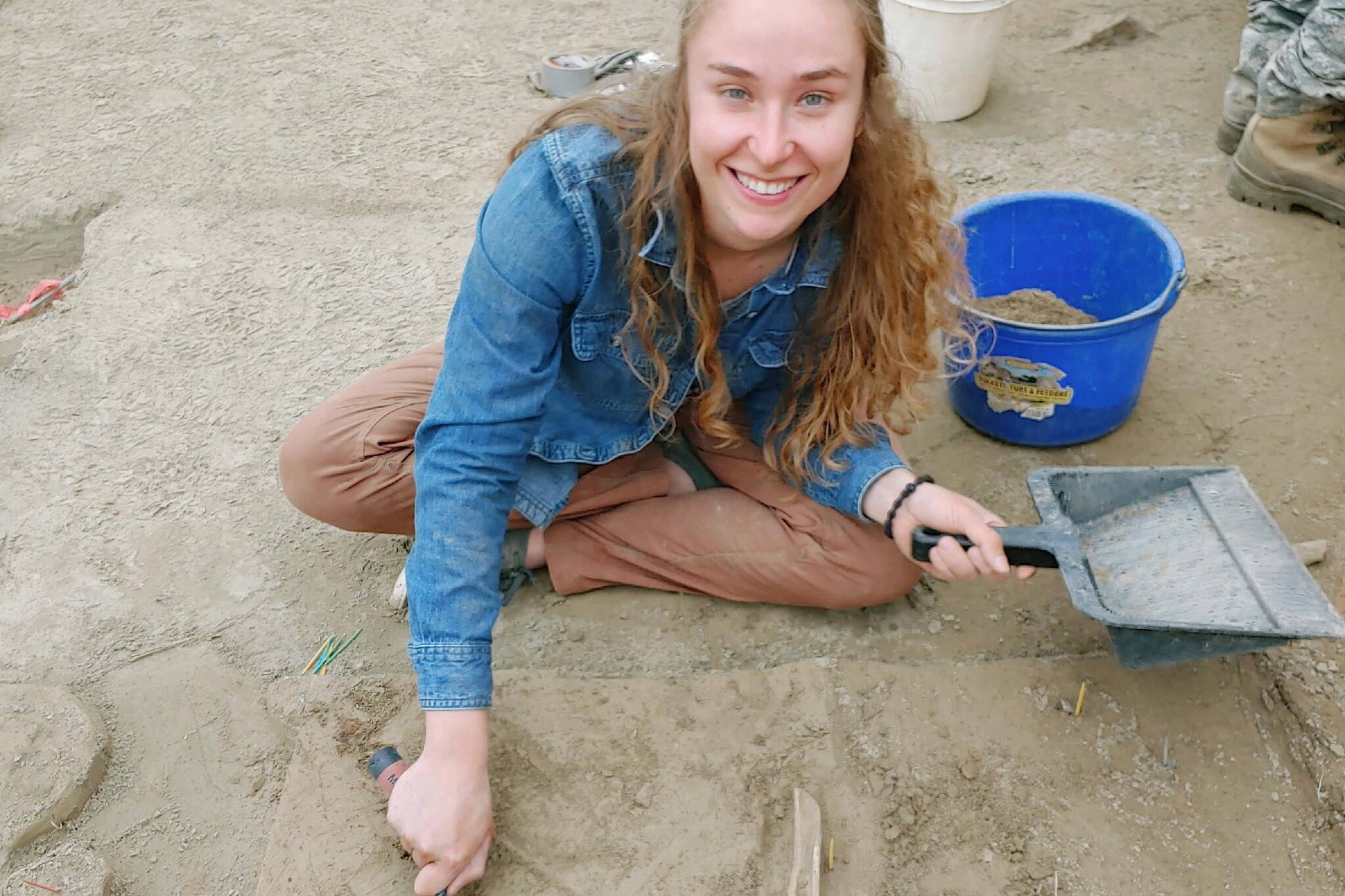The female woolly mammoth was 20 years old when she stumbled amid the grasslands. She fell in a cloud of dust, then gasped her last breath of cool air. It was a late-summer day, 14,000 years ago.
Over her lifetime, this creature had wandered from Canada’s Yukon territory into Alaska, where she died at what should have been the peak of her life.
Members of the Healy Lake Village Council — upon whose lands the mammoth fell — have named her “Élmayųujey’eh.”
A group of scientists, led by several at the University of Alaska Fairbanks, have reconstructed the life of that mammoth. They have nicknamed her Elma.
The researchers have also postulated on Elma’s death — suggesting that people may have killed her.
Audrey Rowe is the lead author on a paper that is her Ph.D. study as well as the cover story in the most recent issue of Science Advances.
Rowe works with UAF’s Matthew Wooller as a student in UAFs interdisciplinary studies program and the College of Fisheries and Ocean Sciences.
In a study that has “taken up the last couple years of my life, in a good way,” Rowe and her colleagues used physical clues within the tusk, along with a computer model that simulated potential walking paths of the female mammoth, to write Elma’s life story.
Though archaeologists have found evidence of ancient people butchering mammoths in Eurasia, Siberia and elsewhere in the Americas, researchers in Alaska had not previously made that connection due to a lack of direct evidence, such as finding a mammoth kill site or mammoth bones scored by sharp objects.
But if ancient Alaskans did hunt mammoths, imagine the bounty: A female woolly mammoth could weigh as much as 8,800 pounds, eight times the size of a large cow moose.
As far as we know, mammoths became extinct on mainland Alaska about 12,000 years ago. That is the date of the youngest mammoth fossil found in the Interior.
Scientists have debated how mammoths might have disappeared from middle Alaska. A changing climate in which trees and shrubs were crowding out grasslands is one possibility. Another is that people overhunted them. Maybe it was a combination of the two.
Rowe started her investigation with the end of the mammoth’s life. One of the few things scientists knew for sure was that archaeologists found her tusk years ago at a site called Swan Point.
Swan Point is a knoll that rises above Shaw Creek Flats north of Delta Junction and south of Fairbanks. Views of the surrounding plain are excellent today. They were even better before the encroachment of trees.
In the vicinity are several other forested sand dunes that were also campsites of ancient people who lived there as the late great ice age was waning.
In their paper, Rowe and her colleagues described mammoth bones, tusks and teeth found at eight sites in Alaska and the Yukon, many of them near Swan Point. They suggest that early people in these regions may have set up their camps in areas where mammoths tended to gather.
A key piece of evidence is a new date on Elma’s tusk. Years ago, researchers estimated the tusk’s age to a few hundred years before people occupied the hill at Swan Point. They thought the ancient people had perhaps found the tusk on the countryside (possibly from an extinct mammoth) and hauled it to Swan Point for use as an anvil or a hard material from which to chip weapon points.
But recent carbon dating of many elements of Swan Point executed by UAF’s Josh Reuther, Rowe and others showed that Elma’s tusk dates to a time that ancient people were present at Swan Point, from 13,000 to 14,000 years ago.
In addition to yielding a new radiocarbon date, the tusk’s annual-growth rings gave the scientists a biography of the mammoth’s life.
Minerals within the tusk allowed the scientists to use sophisticated instruments at UAF’s Alaska Stable Isotope Facility to determine where the animal wandered during her 20 years of life. Rowe and others did this by comparing the values for each growth year of Elma’s tusk to geologic maps of Alaska and the Yukon.
The method was precise enough that the scientists could estimate that Elma died in late summer or fall, when ancient people at the sites were also hunting migrating waterfowl, elk and other animals.
There were other mammoth remains — a shattered tooth and some ribs — at Swan Point. Through DNA testing, Rowe and others concluded those mammoths were from the same family group as Elma. Perhaps ancient people harvested the mammoths as a group. They had the technology to kill a mammoth — sharpened stone blades that could be attached to shafts to make spears or lethal darts.
The scientists also think that Elma and other mammoths were adapting to a changing climate. Back then, trees were invading lower elevations and slowly crowding out mammoth foods.
“She seems to have preferred higher elevations,” Rowe said of Elma. “She didn’t really go below 400 meters (about 1,300 feet) in her lifetime.
“The grasses and forbs pushed her to a higher altitude, because the ground was being transformed into swamp.”
Elma might have avoided the swamp because then, like today, large-bodied creatures with small feet would have a hard time moving through it.
In a brief summary they wrote about their recent paper, Rowe and 19 other co-authors said that we are now living in a period similar to Elma’s.
“We are currently experiencing profound changes in global climate, which are more pronounced in the far north,” they wrote. “The last time this magnitude of climate change occurred was during the end of the last Ice Age … when a large number of creatures, including mammoths, went extinct.”
• Since the late 1970s, the University of Alaska Fairbanks’ Geophysical Institute has provided this column free in cooperation with the UAF research community. Ned Rozell ned.rozell@alaska.edu is a science writer for the Geophysical Institute.

